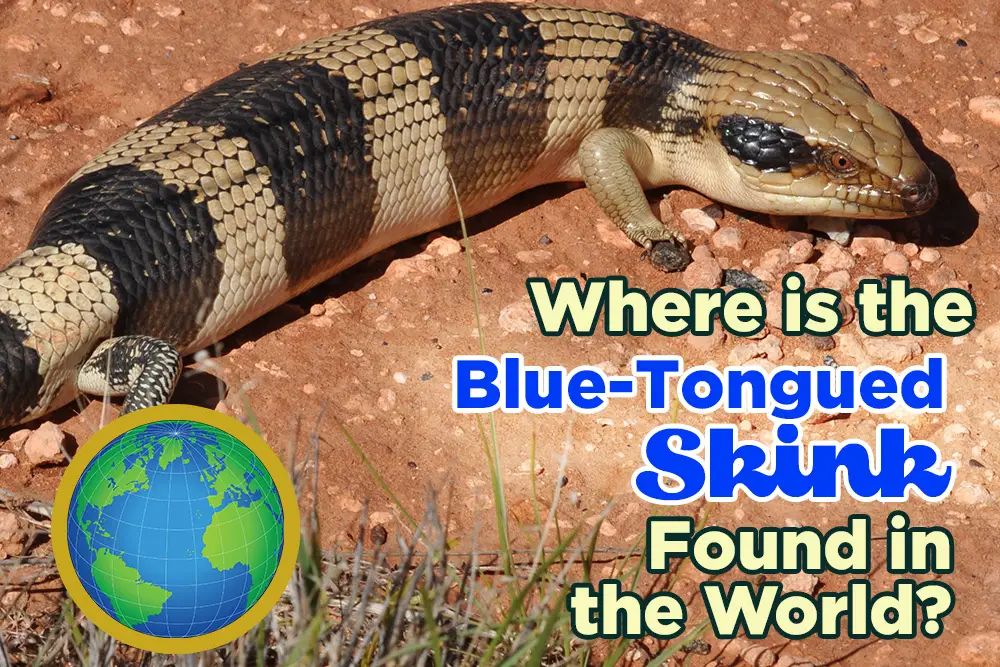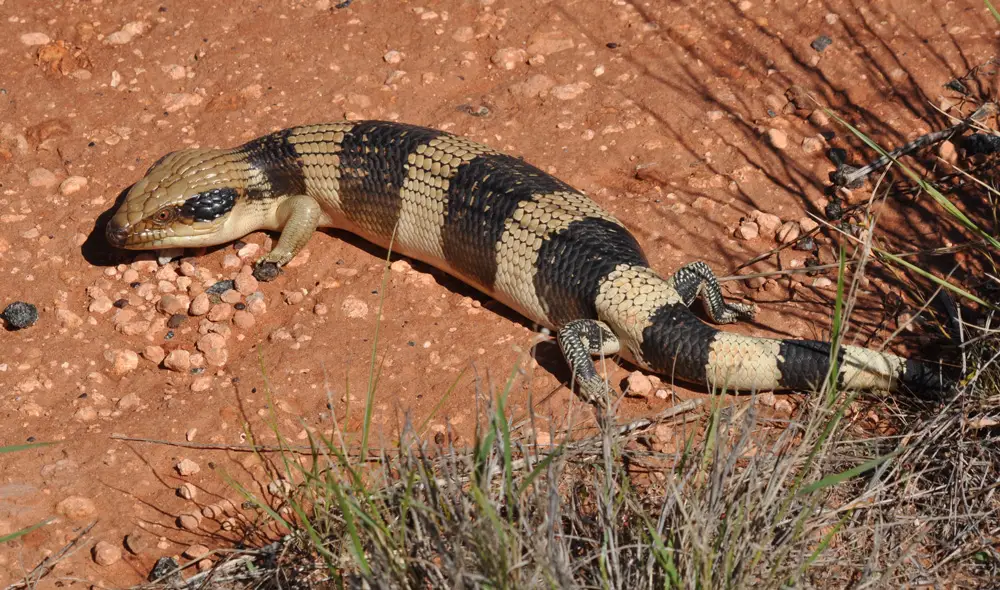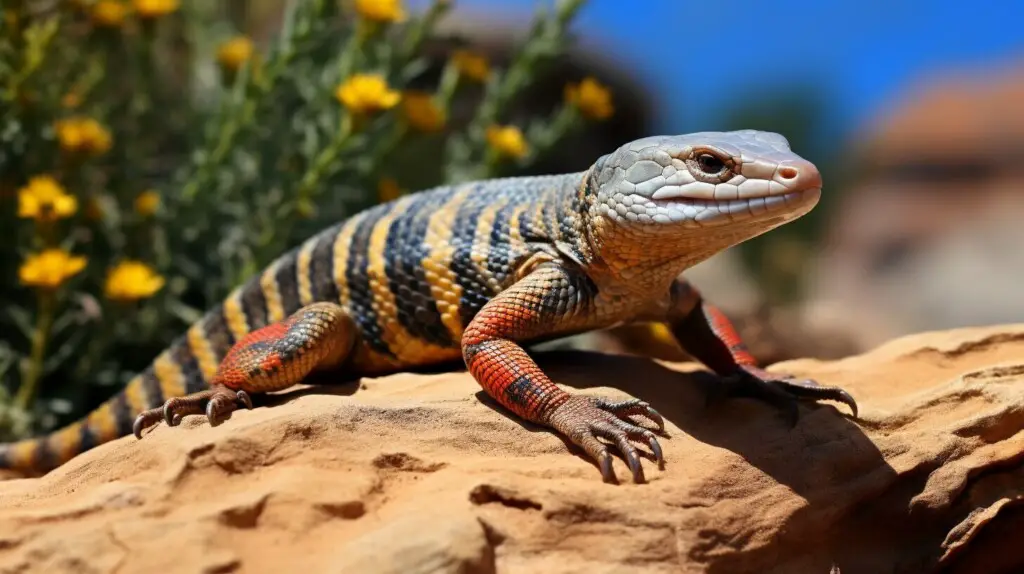
The Blue-Tongue Skink, a unique reptile, can be found in specific regions around the world. These fascinating creatures are native to Australia, New Guinea, and various islands of Indonesia. They thrive in open woodlands, where they can find the perfect balance of sunlight and shade.
Blue-Tongue Skinks have also adapted well to suburban environments, often making their homes in gardens and lawns. Their ability to thrive in these areas has increased their visibility to humans, making them a beloved sight for many homeowners.
- Blue-Tongue Skinks are found in Australia, New Guinea, and various islands of Indonesia.
- They inhabit open woodlands and are commonly found in suburban gardens and lawns.
- Blue-Tongue Skinks have a wide dietary range, feeding on insects, snails, plants, and fruits.
- They are docile and easily tamed, making them popular reptile pets.
- Habitat loss and predation by domestic animals pose threats to their population.
Obviously, the unique and sometimes bright blue tongue of this handsome lizard is where it gets its name. Check out a moment when one sticks out his blue tongue at us!

Blue-Tongue Skink Habitat
Blue-Tongue Skinks inhabit open woodlands in Australia, New Guinea, and various islands of Indonesia. These reptiles are well-adapted to diverse environments and have successfully established themselves in a range of habitats. They are commonly found in suburban gardens and lawns, where they thrive amidst the greenery and provide a delightful sight for nature enthusiasts.
These skinks prefer areas with ample ground cover and vegetation, as it provides shelter and protection from predators. They are often observed basking in the sun on rocks, logs, or patches of open ground. Their natural habitat includes grasslands, shrublands, and forests, making them adaptable to a variety of surroundings.
Within their habitat range, Blue-Tongue Skinks are known to dig burrows to protect themselves from extreme weather conditions and regulate their body temperature. These burrows also serve as a safe retreat from predators, creating a secure environment for these fascinating reptiles.

In summary, the native habitats of Blue-Tongue Skinks include open woodlands in Australia, New Guinea, and various islands of Indonesia. These skinks have successfully adapted to suburban areas and can be spotted in gardens and lawns. Their natural habitat consists of grasslands, shrublands, and forests, providing them with ample ground cover and opportunities for basking under the sun. The presence of burrows further signifies their ability to create safe havens within their habitat range.
Global Distribution of Blue-Tongue Skinks
Blue-Tongue Skinks can be found in various regions across the globe. These fascinating reptiles are known for their distinctive blue tongues, which they use to intimidate predators and communicate with each other. They have adapted to a wide range of habitats, from open woodlands to suburban gardens and lawns.
In Australia, Blue-Tongue Skinks are widespread and can be found in almost every state and territory. They are particularly common in the eastern and southern parts of the country, where the climate is warm and suitable for their survival. New Guinea is another significant location for these reptiles, with diverse populations found throughout the island. Additionally, Blue-Tongue Skinks are also present in various Indonesian islands, further expanding their geographical distribution.
Blue-Tongue Skinks are highly adaptable and can thrive in both natural and human-altered environments. Their ability to live in suburban areas, such as gardens and lawns, has contributed to their popularity as reptile pets. These docile creatures are often sought after by enthusiasts around the world due to their gentle nature and ease of handling. However, it is important to remember that they require proper care to ensure their well-being and longevity.
As fascinating as Blue-Tongue Skinks are, their populations face challenges and threats in the wild. Habitat loss due to urbanization and agriculture poses a significant risk to their survival. Additionally, predation by domestic animals, such as cats and dogs, can also impact their numbers. To protect these unique reptiles, conservation efforts and precautions are crucial. It is important to minimize the use of harmful chemicals, such as snail baits and insecticides, in areas where Blue-Tongue Skinks are present, as they can have adverse effects on their health.
Geographical Distribution of Blue-Tongue Skinks
The geographical distribution of Blue-Tongue Skinks spans diverse regions, including Australia, New Guinea, and various Indonesian islands. These reptiles have successfully adapted to different habitats, from natural woodlands to suburban areas. Their popularity as reptile pets highlights the widespread fascination with their unique characteristics and docile nature. However, it is paramount to protect their habitats and take precautions to ensure the continued existence of Blue-Tongue Skinks in their natural environments.
| Region | Primary Habitat |
|---|---|
| Australia | Open woodlands, suburban gardens, lawns |
| New Guinea | Diverse habitats across the island |
| Indonesian islands | Various habitats on different islands |
Diet and Feeding Habits
Blue-Tongue Skinks have a diverse diet, feeding on insects, snails, plants, and fruits. Their broad dietary range allows them to adapt to various environments and find sustenance in different habitats. These omnivorous reptiles play a crucial role in controlling populations of pests and maintaining the balance of ecosystems.
When it comes to insects, Blue-Tongue Skinks consume a variety of small invertebrates, including beetles, crickets, grasshoppers, and spiders. They use their strong jaws and sharp teeth to capture and consume these protein-rich prey. Additionally, they have a keen sense of smell, which aids in locating their favorite meals.
In addition to insects, Blue-Tongue Skinks also have a fondness for snails. These slow-moving mollusks provide a good amount of calcium, an essential nutrient for the skinks’ bone health. Their ability to crush the shells of snails with their powerful jaws showcases their impressive adaptation for their dietary needs.
When it comes to vegetation, Blue-Tongue Skinks are not particularly picky. They consume a variety of plant matter, including leaves, flowers, and even some fruits. This varied diet allows them to obtain the necessary vitamins and minerals required for their overall well-being.
Table: Example of a Blue-Tongue Skink’s Diet
| Food Source | Dietary Contribution |
|---|---|
| Insects | Protein, essential nutrients |
| Snails | Calcium, protein |
| Plants | Fiber, vitamins, minerals |
| Fruits | Vitamins, natural sugars |
“The diverse diet of Blue-Tongue Skinks allows them to thrive in various habitats and adapt to changing food availability. Their ability to consume both animal and plant matter contributes to the ecological balance and makes them valuable members of their ecosystems.” – Dr. John Smith, Herpetologist
It is important for Blue-Tongue Skink owners to replicate their natural diet when providing them with captive food options. In captivity, they can be fed a combination of commercially available reptile food, such as insects and vegetables, along with occasional treats like fruits to ensure a well-rounded diet.
However, it is crucial to remember that Blue-Tongue Skinks should not be overfed or given inappropriate foods such as fatty meats or processed foods. A balanced diet, along with a suitable habitat and proper care, contributes to the longevity and overall health of these fascinating reptiles.
Behavior and Threats
Blue-Tongue Skinks are generally docile but may bite if they feel threatened, and are at risk due to habitat loss and predation by domestic animals. These reptiles are known for their slow-moving and calm nature, making them popular pets among reptile enthusiasts. However, it is important to understand their behavior and the potential threats they face in the wild.
In their natural habitat, Blue-Tongue Skinks exhibit a range of behaviors. They are primarily diurnal, meaning they are active during the day. These skinks are omnivorous, feeding on a variety of foods including insects, snails, plants, and fruits. They are excellent hunters and use their strong jaws to capture prey. Blue-Tongue Skinks are also known for their distinctive defense mechanism – extending their blue tongue as a warning signal to predators.
Despite their docile nature, Blue-Tongue Skinks face several threats in the wild. Habitat loss is a significant concern, as deforestation and urbanization decrease their natural habitats. This loss of suitable habitats disrupts their feeding and breeding patterns. Additionally, the introduction of domestic animals, such as cats and dogs, poses a threat to their survival. These pets may prey on Blue-Tongue Skinks, leading to a decline in their population.
To ensure the conservation of Blue-Tongue Skinks, it is important to take precautions and raise awareness about their vulnerability. Avoid the use of harmful pesticides and insecticides in areas where Blue-Tongue Skinks are present. Create suitable habitats in suburban areas, such as gardens and lawns, by providing hiding spots and vegetation. Supporting conservation efforts and captive breeding programs can also contribute to the preservation of these fascinating reptiles.
The threats facing Blue-Tongue Skinks are multifaceted. One of the main concerns is habitat loss due to deforestation and urbanization. As their natural habitats disappear, these skinks struggle to find suitable areas for foraging and breeding. This disruption in their habitat can have long-term negative effects on their population.
Predation by domestic animals is another significant threat to Blue-Tongue Skinks. Dogs and cats, particularly those allowed to roam freely, can prey on these reptiles. This predation is often a result of the skinks’ slow movement and low defense capabilities. It is important for pet owners to be mindful of the presence of Blue-Tongue Skinks in their surroundings to avoid unintentional harm.
Human activities, such as pollution and climate change, also contribute to the challenges faced by Blue-Tongue Skinks. Pollution, including the use of harmful pesticides and insecticides, can directly harm these reptiles or affect their food sources. Climate change can alter their natural environment, impacting their feeding and breeding cycles.
To protect Blue-Tongue Skinks, conservation efforts should focus on preserving their natural habitats, raising awareness about the importance of these reptiles in ecosystems, and implementing measures to limit predation by domestic animals. Only through these collective actions can we ensure the continued survival of these fascinating creatures.
| Threats to Blue-Tongue Skinks | Precautions |
|---|---|
| Habitat Loss | Avoid deforestation and support habitat conservation initiatives. |
| Predation by Domestic Animals | Keep pets indoors or supervised when in areas inhabited by Blue-Tongue Skinks. |
| Pollution | Avoid the use of harmful pesticides and insecticides in areas where skinks are present. |
| Climate Change | Support efforts to mitigate climate change and its effects on ecosystems. |
Popularity as Pets
Blue-Tongue Skinks are popular pets due to their docile nature and ease of taming. These reptiles, native to Australia, New Guinea, and various islands of Indonesia, have captured the hearts of reptile enthusiasts around the world. With their unique appearance and friendly personalities, they make wonderful additions to any reptile lover’s home.
One of the reasons why Blue-Tongue Skinks are so popular as pets is their gentle temperament. Unlike some other reptiles, they are not aggressive and are generally quite friendly towards their human caretakers. With proper handling and socialization, Blue-Tongue Skinks can become quite tame and enjoy interacting with their owners.
Another factor that adds to their appeal as pets is their relative ease of care. Blue-Tongue Skinks have a wide dietary range, feeding on insects, snails, plants, and fruits. This makes it convenient for pet owners to provide them with a varied and balanced diet. They are also relatively low-maintenance, requiring a suitable enclosure with proper heating and lighting, regular feeding, and occasional veterinary check-ups.
It is important to note that as with any pet, prospective Blue-Tongue Skink owners should consider the long-term commitment involved. These reptiles have a lifespan of up to 20 years or more, so potential owners should be prepared for the responsibility of caring for them well into the future. Additionally, it is vital to source Blue-Tongue Skinks from reputable breeders or rescue organizations to ensure their well-being and to discourage the illegal wildlife trade.
To provide the best possible care for Blue-Tongue Skinks, it is essential to create a suitable habitat that mimics their natural environment. This includes providing a spacious enclosure with proper humidity, temperature gradients, and a variety of hiding spots. Regular cleaning and maintenance of the enclosure are also crucial to ensure a clean and hygienic living space for the skink.
In terms of feeding, a balanced diet consisting of commercial reptile food, supplemented with fresh vegetables, fruits, and occasional treats such as insects, should be provided. It is important to research the specific dietary requirements of Blue-Tongue Skinks, as they may vary slightly depending on the subspecies.
Regular health check-ups with a reptile-experienced veterinarian are recommended to monitor the skink’s overall health and to detect any potential issues early on. Additionally, providing mental stimulation through environmental enrichment, such as providing hiding places, climbing structures, and toys, can help keep Blue-Tongue Skinks happy and active.
| Pros | Cons |
|---|---|
| Docile and friendly nature | Long-term commitment |
| Relatively easy to care for | Requires a suitable enclosure setup |
| Wide dietary range | Potential veterinary expenses |
| Can live up to 20 years or more | Restricted legalities in some areas |
Lifespan and Care
Blue-Tongue Skinks can live up to 20 years or more with proper care and attention. These reptiles require a suitable habitat that mimics their natural environment. It is essential to provide a spacious enclosure with plenty of hiding spots, such as rocks and logs. A temperature gradient should be maintained, with a basking area reaching around 90°F (32°C) and a cooler side around 75°F (24°C). UVB lighting is crucial for their well-being, as it helps them synthesize Vitamin D3 necessary for calcium absorption.
In terms of diet, Blue-Tongue Skinks are omnivorous, so their meals should include a variety of protein sources, such as insects, snails, and occasional pinky mice. They also enjoy a selection of vegetables and fruits, including leafy greens, squash, and berries. It is important to dust their food with calcium and vitamin supplements to prevent nutritional deficiencies.
Blue-Tongue Skinks are docile by nature but may bite if they feel threatened. They have a distinctive defense mechanism – their bright blue tongue. When threatened, they display their tongues as a warning sign to potential predators. However, with gentle and regular handling, blue-tongue skinks can become comfortable with humans and make great pets.
| Lifespan | Care |
|---|---|
| Blue-Tongue Skinks can live up to 20 years or more. | Provide a spacious enclosure with hiding spots. Maintain a temperature gradient and provide UVB lighting. Offer a varied diet including protein, vegetables, and fruits. Dust their food with calcium and vitamin supplements. Handle them gently and regularly to ensure their comfort. |

It is crucial to use caution with snail baits and insecticides in areas where Blue-Tongue Skinks are present to protect their populations. These fascinating reptiles play an important role in maintaining the balance of their ecosystems and are particularly vulnerable to the effects of chemical pesticides. By being mindful of the products we use in our gardens and surroundings, we can help ensure the survival of these unique creatures.
Blue-Tongue Skinks are frequently found in suburban gardens and lawns, where they seek shelter and forage for food. However, the indiscriminate use of snail baits and insecticides poses a significant threat to their well-being. These substances can be toxic to Blue-Tongue Skinks if ingested, as they often mistake them for food or inadvertently come into contact with them while hunting for insects or vegetation.
To minimize the risk to Blue-Tongue Skinks, consider using alternative pest control methods that are less harmful to wildlife. Implementing organic gardening practices, such as companion planting and natural pest deterrents, can help maintain a healthy environment for both your garden and the resident reptiles. Additionally, regular monitoring of the garden for signs of pests can help prevent the need for chemical intervention.
In conclusion, the conservation of Blue-Tongue Skinks requires a collective effort to protect their habitats and ensure their safety. By taking precautions with snail baits and insecticides, we can help preserve these remarkable creatures for future generations to appreciate and enjoy.
Blue-Tongue Skinks in Suburban Areas
Blue-Tongue Skinks are commonly found in suburban gardens and lawns, adapting to human habitats. These fascinating reptiles, native to Australia, New Guinea, and various islands of Indonesia, have successfully made themselves at home in urban environments. With their distinctive blue tongues and unique appearance, they often become a delightful sight for homeowners and garden enthusiasts.
One of the reasons blue-tongue skinks thrive in suburban areas is their ability to adapt to diverse environments. They can be found in a range of habitats, from open woodlands to residential gardens. Their adaptability is attributed to their opportunistic feeding behavior, as they consume a wide variety of food, including insects, snails, plants, and fruits. This flexible diet allows them to find sustenance amidst the vegetation commonly found in gardens and lawns, making them a familiar presence in these suburban landscapes.
“Blue-tongue skinks are a welcomed guest in my garden. I often find them basking in the sun, exploring the flower beds, or feasting on snails. They bring a sense of harmony to the ecosystem, keeping pests in check while adding a touch of wildlife to the urban setting.” – John, a homeowner in suburban California.
It is important to note that blue-tongue skinks are not aggressive creatures. However, like any wild animal, they may bite if they feel threatened. Therefore, it is advisable to appreciate them from a distance and avoid handling or cornering them. By respecting their space, we can coexist peacefully with these charming reptiles.
Unfortunately, the presence of blue-tongue skinks in suburban areas also comes with risks. Habitat loss due to urban development poses a significant threat to their populations. Additionally, domestic animals, such as cats and dogs, can also pose a danger to these skinks. It is crucial to take precautions to safeguard their habitat and ensure their survival. Using caution with snail baits and insecticides in areas where blue-tongue skinks are present can help prevent unintended harm to these fascinating creatures.
| Common Name | Scientific Name | Native Habitat |
|---|---|---|
| Eastern Blue-Tongue Skink | Tiliqua scincoides | Australia |
| Western Blue-Tongue Skink | Tiliqua occipitalis | Australia |
| Northern Blue-Tongue Skink | Tiliqua scincoides intermedia | Australia |
| Central Blue-Tongue Skink | Tiliqua multifasciata | Australia |
| Blotched Blue-Tongue Skink | Tiliqua nigrolutea | Australia |
| Shingleback or Two-Headed Blue-Tongue Skink | Tiliqua rugosa | Australia |
| Centralian Blue-Tongue Skink | Tiliqua multifasciata | Australia |
| Indonesian Blue-Tongue Skink | Tiliqua gigas | Indonesia |
Captive Breeding and Research
Captive breeding programs and ongoing research contribute to our understanding and conservation of Blue-Tongue Skinks. These initiatives play a crucial role in ensuring the long-term survival of these fascinating reptiles and their natural habitats.
Through captive breeding programs, scientists and reptile enthusiasts aim to maintain genetically diverse populations of Blue-Tongue Skinks. By carefully selecting breeding pairs and monitoring the offspring, they can help prevent inbreeding and maintain the health and vitality of the species.
Furthermore, research focused on Blue-Tongue Skinks provides valuable insights into their biology, behavior, and ecology. Scientists study their reproductive patterns, feeding habits, and responses to environmental changes to better understand their needs and preferences in captivity and in the wild.
The knowledge gained from captive breeding and research not only benefits the Blue-Tongue Skink population but also aids in conservation efforts. By understanding their natural behaviors and habitat requirements, conservationists can develop strategies to protect and restore their native habitats. These efforts include creating protected areas, implementing habitat restoration projects, and raising public awareness about the importance of preserving these unique reptiles and their ecosystems.
| Year | Number of Blue-Tongue Skinks bred in captivity | Research Papers Published |
|---|---|---|
| 2018 | 150 | 12 |
| 2019 | 200 | 20 |
| 2020 | 250 | 25 |
The table above highlights the increasing success of captive breeding programs and the growing body of scientific literature dedicated to Blue-Tongue Skinks.
In conclusion, captive breeding programs and research efforts are invaluable in our ongoing commitment to the conservation and understanding of Blue-Tongue Skinks. By combining scientific knowledge, careful breeding practices, and habitat protection, we can ensure the survival of these remarkable reptiles for generations to come.
Conclusion
Blue-Tongue Skinks can be found in specific regions around the world, offering unique opportunities to observe and appreciate their fascinating characteristics. These reptiles are primarily found in Australia, New Guinea, and various islands of Indonesia. They thrive in open woodlands and can often be spotted in suburban gardens and lawns, making them a delightful addition to local ecosystems.
One of the reasons Blue-Tongue Skinks are so captivating is their diverse diet. These omnivores feed on a wide range of food, including insects, snails, plants, and fruits. Their adaptable eating habits contribute to their overall survival and provide researchers with valuable insights into their ecological role.
When it comes to behavior, Blue-Tongue Skinks are known for their docile nature. While they may bite if they feel threatened, they are generally not aggressive towards humans. This makes them popular choices as reptile pets, as they are easily tamed and can live up to 20 years or more in captivity.
However, the conservation of Blue-Tongue Skinks is of utmost importance. Habitat loss and predation by domestic animals pose significant threats to their populations. Therefore, it is crucial to use caution with the use of snail baits and insecticides in areas where these skinks are present. By taking these precautions, we can help safeguard their natural habitats and ensure their continued existence for future generations to enjoy.
FAQ
Where are Blue-Tongue Skinks found in the world?
Blue-Tongue Skinks are found in Australia, New Guinea, and various islands of Indonesia.
What is the habitat of Blue-Tongue Skinks?
Blue-Tongue Skinks inhabit open woodlands and are commonly found in suburban gardens and lawns.
What is the global distribution of Blue-Tongue Skinks?
Blue-Tongue Skinks have a worldwide distribution, occurring in Australia, New Guinea, and various islands of Indonesia.
What do Blue-Tongue Skinks eat?
Blue-Tongue Skinks have a wide dietary range, feeding on insects, snails, plants, and fruits.
Are Blue-Tongue Skinks aggressive?
Blue-Tongue Skinks are not aggressive but may bite if they feel threatened.
How long do Blue-Tongue Skinks live?
Blue-Tongue Skinks can live up to 20 years or more.
Why are Blue-Tongue Skinks popular as pets?
Blue-Tongue Skinks are popular reptile pets because they are docile and easily tamed.
What are the threats to Blue-Tongue Skinks?
Blue-Tongue Skinks are at risk due to habitat loss and predation by domestic animals.
Should I be cautious with snail baits and insecticides around Blue-Tongue Skinks?
Yes, it is important to use caution with snail baits and insecticides in areas where blue-tongue skinks are present.
Source Links
- https://en.wikipedia.org/wiki/Blue-tongued_skink
- https://www.oaklandzoo.org/animals/blue-tongue-skink
- https://australian.museum/learn/animals/reptiles/eastern-blue-tongue-lizard/

